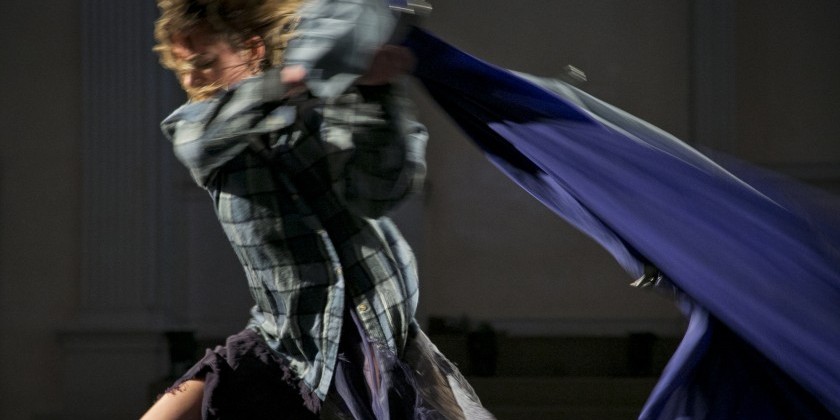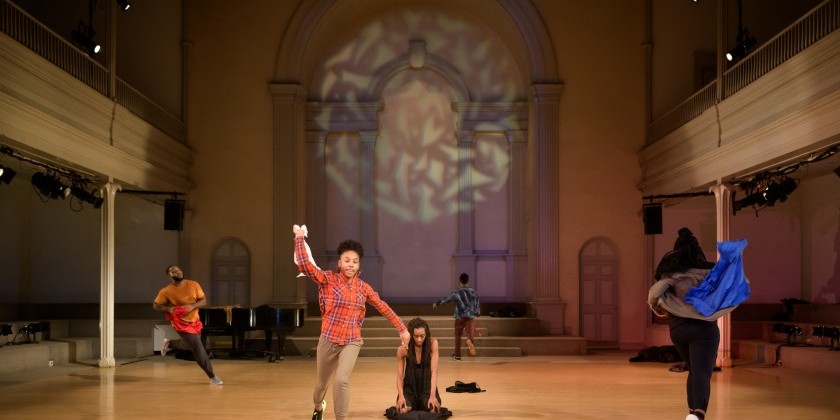Impressions of: "Slavic Goddesses — A Wreath of Ceremonies" by Artist Paulina Olowska with Ballez and Katy Pyle at The Kitchen

Thursday, January 26, 2017
Conceived by Paulina Olowska
Choreographed by Katy Pyle in collaboration with Ballez Dancers
Original Music Composition by Sergei Tcherepnin
Performance by Ballez Dancers: Jules Skloot, Lindsay Reuter, Mei Yamanaka, Deborah Lohse, Madison Krekel, and Charles Gowin
Lighting Design by Madeline Best
with inspirational quotes of Zofia Stryjeńska and Paulina Olowska
Costume Design by Paulina Olowska based on Zofia Stryjeńska
The opening image of visual artist Paulina Olowska’s Slavic Goddesses — A Wreath of Ceremonies is an arresting one. Snow falls softly on dancer Madison Krekel, who wears an elaborate cyclical headdress with long cardboard oars. Representing Morena, goddess of winter and death, she steps gingerly from side to side with a live, slippery Branzino fish in her hand. Only her arched feet and ankles are exposed under her flared skirt. The solo is surreptitious, and the subtle quirks that Krekel brings to the role — her eyes dart and rapidly blink — further fuels its mystery. The fate of the fish remains unknown.
A series of solos follows this enigmatic opening, all performed by members of Ballez, Katy Pyle’s innovative troupe that explores, “The history, lineage, and bodies of lesbian, transgender, and gender-non-conforming queer people into the ballet cannon.” Each dancer, whether male or female, represents a colorful goddess from Slavic folklore. To animate these characters, Olowska drew inspiration from Polish artist Zofia Stryjeńska’s 1918 series Bożki słowiańskie (Slavic Deities), which features delicately shaded lithographs.
Having seen many of these technically adept and captivating performers in Ballez’s breakout The Firebird and other choreographers’ works, I’m disappointed by the lack of movement. While Olowska’s visually lavish creations are masterful, they’re also unwieldy, hindering the artists’ movements and dynamism.
Despite flat pacing, a handful of moments stand out. Jules Skloot as Lelum, the goddess of mischief, is infectious. He cackles and grapevines cartoonishly with unbridled enthusiasm. Lindsay Reuter’s interpretation of Pepperuga, goddess of prosperity, is puckish and poignant. Her unitard with its detachable colorful little house allows her to move more freely than her counterparts. She dazzles as she skitters across the stage, her hand flitting furiously like the wing of a bird in front of a cloud of neon yellow light.
Pyle, per the press release, incorporates folk steps like the Mazurka and the Polish spinning step Oberek in the choreography to “consider the history of ballet as a site of folk dance appropriation.” She nods to these cultural steps even as the weight of the costumes, both physically and metaphorically, stifles and inhibits. Slavic Goddesses — A Wreath of Ceremonies doesn’t break free from ballet’s tradition of manicuring folk dances to sterilized precision. Though this may be the artist’s intention, the work begs its magnetic performers to ditch their costumes and run free.












